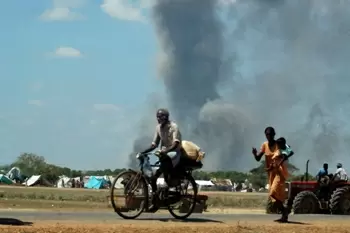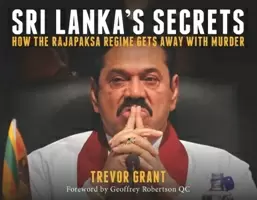A latest book has more poignant tales of Tamils, showcasing the sadism of Sinhalese, in Lanka

06-September-2014
Vol 5 | Issue 36
That Sri Lankan military brutalizes Tamils is old hat. The Weekend Leader reproduces below an excerpt from a new book by Trevor Grant, Sri Lanka’s Secrets: How the Rajapaksa Regime Gets Away with Murder, which has more chilling facts
Rajapaksa cannot tolerate an inquiring media, because he has so much to hide. At every turning, in every nook and cranny of communal life, especially in the north, where the military brutalises the people on a daily basis, there are stories of terror and abject misery. Peter Arndt, the Brisbane-based executive officer of the Catholic Justice and Peace Commission, discovered this bleak truth during a visit to Vavuniya, in the heart of the Tamil homeland, in September 2013. His group met with a dozen women, all of whom were either the wives or mothers of Tamil men who were jailed, tortured, and in some cases killed.
.webp) |
|
A woman desperately seeks shelter for her child (Photos Courtesy: Monash University Publishing)
|
The stories were depressingly the same. The men were questioned by authorities who were trying to get them to admit an association with the Tamil Tigers. There was often torture involved. Characteristically, the stories we got were that the men were made to kneel, their legs were trampled on and they were beaten.
Ethnic-cleansing and genocide were words I heard from the mouths of the Tamil people there. You know it’s true when you see the group of women I met; when you learn how the authorities were continually taking in men, in particular, with scant or no evidence, detaining them, separating them from their wives and families; you know it when you see the military authorities moving into that territory and marginalising the Tamil people in every way they can economically. Many people are not able to resume their normal occupations; the army and navy are taking away all the economic opportunities.
People who speak out are always in difficulty. We were meant to meet a Jesuit priest there. He works with families of the forcibly disappeared and was one of two Catholic human rights workers who met with Navi Pillay on her trip just before we arrived. After the visit, the authorities questioned him. He’s been constantly threatened and followed ever since. Normally, he would have come to our gathering to talk about the situation. But we were told he simply doesn’t come to those meetings because he would bring the authorities with him. They follow him everywhere.
 |
|
Bombs would hit the No Fire Zone, smoke would rise and people would scatter in all directions
|
If there were any doubts left in Arndt’s mind about the human cost of Sri Lankan government policy towards Tamils, they were dispelled when he made a visit to the homes of two victims.
I’ll never forget these two women. One of them had moved with her husband and son from Jaffna to Vavuniya so the son could study at a technical college. They had invested all their hopes in him. The husband was too sick to work. The son’s future income was everything to them. One day he was taken into custody. When he and others were going to be moved to a jail down south, well away from their families, the prisoners protested. They were severely beaten. He died a few days later. His legs were broken and his body bruised from being beaten with chains. They even tried to force his mother to sign a letter saying he died of a heart attack.
Today she is filled with anger and sadness, and hopelessness. She took us back to her very simple home, a one-room mud-brick house with coconut thatching, about the size of a normal Australian bedroom; no electricity, holes in the roof. There was a little shrine in that one room to her son who was gone, and with him their hope of any future gone, replaced by a life of misery and poverty.
The other woman was without her husband, who had been detained for some time. She had a child-like voice and cried all the time, as did the other women when they told their stories. I remember when we had finished lunch with them and they were going, this woman came back to say thank-you. There was just so much emptiness in her gentle voice as she said goodbye. I can never forget that sound; how heart-broken and desolate she felt … (Interview with the author, October 2013.)
 |
|
A man believed to be burnt by a phosphorous bomb waits by the roadside for medical help
|
Memory is always the most critical weapon in the fight against genocide, and this is why the Sri Lankan Government expends so much energy trying to obfuscate, distort, misrepresent, ignore or erase the shocking reality of the programmed terror that fills the lives of Tamils.
No aspect of daily life escapes the reach of the smothering hand of the Rajapaksa regime, which, since he assumed power in 2005, has been built on the cult of personality and nationalist ideals that acknowledge only two strains of public thought: patriotism or treachery. Opposition parties have been neutered, the constitution has become a tool of political convenience, with previous limits on presidential terms scrapped, the president granting himself immunity from prosecution, the judiciary losing all pretense of separation from government, not least through the cavalier, illegal ousting of the chief justice in 2013, and the civil police being effectively absorbed into the military, under direct control of the defence secretary and presidential sibling. The government’s economic manifesto bears the name of the president, not the country – ‘Mahinda Chintana’ – and is officially promoted as one man’s ‘Vision of The Future’. A clumsily staged photograph of the dear leader showing the way to a young schoolgirl completes the image of the exalted visionary guiding his country to prosperity and prestige.
 |
Even the national sporting obsession is not immune. In fact, as mentioned earlier, there’s no better way for a tyrant to enlist some serious image enhancement. As the president reclined in the plush red leather seats, and surveyed the action at the shiny, brand-new ‘Mahinda Rajapaksa’ stadium in the opening match of the 2011 World Cup, he was the perfect picture of a man at peace with his surroundings, just as Franco and Mussolini were, in another time in stadiums they built to glorify themselves and their ideals.
There is, of course, always going to be resistance but it’s easily dealt with. When India beat Sri Lanka in the Mumbai final of this World Cup – so vigorously promoted as a symbol of national pride, especially by the president – there were many disaffected Tamils in Jaffna who didn’t feel the same way. Instead, they lit fire-crackers to celebrate the defeat of the team that plays under the banner of the Sinhalese lion. Rajapaksa’s goons were quickly on the scene with their guns and iron bars, to put the recalcitrant youths in their place. Franco and Mussolini would have been proud of him.
(The above excerpt from the book has been reproduced with permission from the publishers)
Sri Lanka’s Secrets: How the Rajapaksa Regime Gets Away with Murder
By Trevor Grant
Published by Monash University, Australia
















